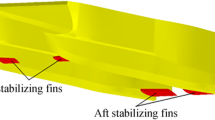Abstract
Hydrodynamic standards have been derived for the improvement of propulsive performance of twin-skeg hull forms. Three important physical observations were used in the optimization of design practice for the stern hull form of twin-skeg ships: limiting streamline pattern on the inner and outer skeg surface of a stern skeg, the balance between the flow intensity over the inner and outer skeg surface of a stern skeg and nominal wake distribution in the propeller plane. Numerical calculations and model tests have been compared to validate a CFD code used in the current work. Based on the stern flow analysis for the evaluation of self-propulsion performance, effects of stern skeg arrangement on the propulsion efficiency, i.e. the distance between skegs and the angle of the skeg with respect to shaft centerline, were intensively investigated. An optimized hull form design for a twin-skeg ship was developed using the design practice derived in this work.
























Similar content being viewed by others
References
Kim J, Park IR, Kim KS, Van SH (2005) RANS computation of turbulent free surface flow around a self-propelled KLNG carrier. J SNAK 42(6):583–592
Kim HT, Kim HT, Van SH (2007) Numerical analysis of flow characteristics of a twin-skeg container ship with variation of stern hull shape. J SNAK 44(6):551–563
Kim JJ, Paik KJ, Lee YC, Kim HT (2006) A numerical study of turbulent viscous flow around a self-propelled ship. In: Proceeding of the annual spring meeting, SNAK, pp 548–557
Stern F, Wilson RV, Coleman H, Paterson EG (2001) Comprehensive approach to verification and validation of CFD simulations-Part 1: methodology and procedures. ASME J Fluids Eng 123(4):793–802
Stern F, Wilson RV, Coleman H, Paterson EG (2001) Comprehensive approach to verification and validation of CFD simulations-Part 2: application for Rans simulation of a cargo/container ship. ASME J Fluids Eng 123(4):803–810
ITTC (1978) Report of performance committee. 15th ITTC, Hague
Boo KT, Hong CB (2006) Self-propulsion performance using CFD. SNAK Annual Autumn Meeting
Hino T (2005) In: Proceeding of CFD Workshop. Tokyo, Japan
Kodama Y (1994) In: Proceedings of CFD workshop Tokyo 1994. Japan
Larsson L (1980) SSPA-ITTC workshop on ship boundary layers. SSPA Publication No. 90
Larsson L, Patel VC, Dyne G (1991) Ship Viscous Flow: Proceedings of 1990 SSPA-CTH-IIHR Workshop. Flowtech International AB, Gothenburg, Sweden
Larsson LF, Stern F, Bertram V (2000) A workshop on numerical ship hydrodynamics, Gothenburg, Sweden
Park IR, Kim WJ, Van SH (2004) Grid generation and flow analysis around a twin-skeg container ship. J Soc Naval Arch Korea 41(1):15–22
Author information
Authors and Affiliations
Corresponding author
About this article
Cite this article
Park, DW., Chun, HH. Design practice for the stern hull form of a twin-skeg ship. J Mar Sci Technol 14, 310–321 (2009). https://doi.org/10.1007/s00773-009-0046-5
Received:
Accepted:
Published:
Issue Date:
DOI: https://doi.org/10.1007/s00773-009-0046-5




